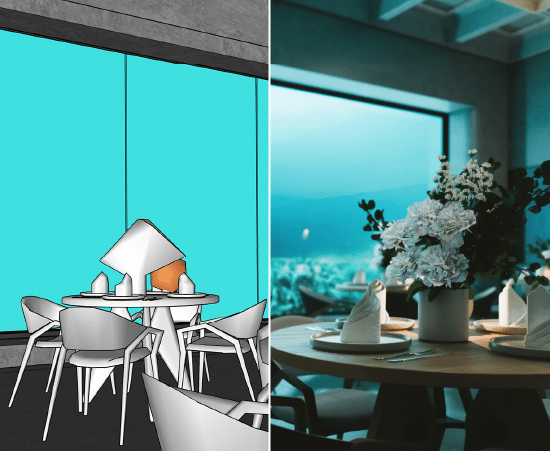A new Future of Architectural Visualization report by 3D visualization experts Chaos has revealed substantial new advancements within real-time rendering, architectural visualizations, and AI technologies.
The Future of ArchViz
The report suggests that real-time rendering is key to many architects’ workflows.
In fact, according to the report, more than 75% of design firms use real-time rendering at least twice per week. Chaos Director of Corporate Development, Roderick Bates, explains the significance:
“The Future of Architectural Visualization report highlights how open the architecture profession is to adopting new technologies. The popularity of real-time rendering has been a long time coming – advances in processing power have made real-time the default, allowing architects to create designs while simultaneously and fluidly generating sophisticated visualizations. While the adoption of real-time rendering has been steady, it is now to the point where it is ‘table stakes’ for many architects. We are now seeing AI as the next technology frontier, and it is being integrated at speed – design professionals are clearly not shying away from AI technology.”
Key takeaways
- 77% of design professionals say their firm is using real-time rendering at least twice per week, with 27% using it daily.
- More than half of firms are already using AI for architectural visualizations.
- 43% of firms have one or more dedicated in-house visualization experts.
Real-time rendering speeds up architectural workflows
As technology advances, clients are expecting more from architects and designers, which leads to heavier workloads. Design professionals are reinventing their workflows so that design processes are more dynamic. A polished effect – achieved during an over-the-shoulder review – is now a realized dream for many.
- 46% of respondents cited that real-time rendering allows them to save time and speed up the design process.
- 1 in 2 respondents report that real-time rendering software will be used to review the project in a real-time viewer during design.
When asked about the main uses of real-time rendering software, respondents indicated that this new approach is helping design professionals to handle hesitant clients.
Charts from Future of Architectural Visualization report. Image: Chaos.
Consequently, it can inform and speed up a client’s decision-making process:
- Quickly applying and reviewing different material options (54.3%).
- Walking through a model with clients or collaborators (50.1%).
- Reviewing daylighting instantly in 3D (47.9%).
Architectural visualization in-house
The report also indicates a preference for architectural visualization to take place in-house. This includes real-time rendering. It also highlights a new requirement for architects to have an understanding of visualization techniques. This marks a shift towards greater autonomy and expertise within firms, regardless of size.
- 43% of firms have one or more dedicated in-house visualization experts.
- 32% of firms have their architects or designers produce their own visualizations.
- Freelancers or small companies (1-5 employees) are more likely than large firms to have designers create their own visualizations.
Greater technical innovation is needed to keep up with demand
As client demands increase, architectural firms are expecting greater performance and functionality from their visualization software. Many firms still face technical challenges and frustrating limitations with their chosen software. The biggest issues with real-time rendering cited were:
- “We are unable to integrate real-time software with our design modelling software.” (48%)
- “Current real-time software does not produce the quality of renderings we need.” (42%)
- “Current real-time software does not have sufficient functionality to meet our needs.” (21%)
More than half of firms are already using AI for architectural visualizations
Designers are also exploring the potential of AI to improve their visualization and overcome rendering challenges. Larger firms are embracing AI faster than smaller firms, but firms of all sizes are planning for future AI investment.
- 55% of design professionals are already using AI in relation to architectural visualization.
- 19% indicated they utilize AI to create AI-assisted or AI-generated visualizations.
- 2 in 5 design professionals see AI as an area for investment over the next year.
Report background
Chaos conducted its survey in collaboration with an online information-sharing platform for architects, Architizer. Moreover, the average participant works in a design firm of twenty to over a hundred employees. A total of 2,139 design professionals were surveyed overall.
Participating firms had a range of specialties, including architecture, interior design, engineering, master planning, landscape architecture, and product design. Respondents’ firms were overwhelmingly headquartered in the United States. However, just over a third were from other countries spread around the world.
- To download and study the report yourself, please click here. Download is free, but it also requires registration with your email address.
About Chaos
Chaos develops 3D visualization technology for architecture, construction, engineering, and media, as well as entertainment, manufacturing, and product design. Its software creates intuitive and powerful workflows for designers of all types.
Chaos is now one of the world’s largest global 3D visualization companies, with more than 700 employees. Its head office is in Karlsruhe, Germany, with offices around the globe. Please click here for more information.
